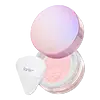Tarte Creaseless Setting & Brightening Powder Versus Charlotte Tilbury Airbrush Brightening Flawless Finish Powder
What's inside
What's inside
 Key Ingredients
Key Ingredients

 Benefits
Benefits

 Concerns
Concerns

 Ingredients Side-by-side
Ingredients Side-by-side

Mica
Cosmetic ColorantSilica
AbrasiveTapioca Starch
Zea Mays Starch
AbsorbentAluminum Starch Octenylsuccinate
AbsorbentLauroyl Lysine
Skin ConditioningAlumina
AbrasiveBoron Nitride
AbsorbentKaolin
AbrasiveWater
Skin ConditioningBenzyl Alcohol
PerfumingCetyl Alcohol
EmollientPhenoxyethanol
PreservativePropanediol
SolventDecylene Glycol
Skin Conditioning1,2-Hexanediol
Skin ConditioningGlycerin
HumectantLonicera Japonica Flower Extract
Skin ConditioningOcimum Basilicum Extract
AntioxidantTrisodium Ethylenediamine Disuccinate
Linalool
PerfumingCitrus Paradisi Fruit Extract
Skin ConditioningVegetable Oil
Skin ConditioningUsnea Barbata Extract
Caprylhydroxamic Acid
Tocopherol
AntioxidantCI 77163
Cosmetic ColorantCI 77742
Cosmetic ColorantCI 77007
Cosmetic ColorantIron Oxides
CI 19140
Cosmetic ColorantMica, Silica, Tapioca Starch, Zea Mays Starch, Aluminum Starch Octenylsuccinate, Lauroyl Lysine, Alumina, Boron Nitride, Kaolin, Water, Benzyl Alcohol, Cetyl Alcohol, Phenoxyethanol, Propanediol, Decylene Glycol, 1,2-Hexanediol, Glycerin, Lonicera Japonica Flower Extract, Ocimum Basilicum Extract, Trisodium Ethylenediamine Disuccinate, Linalool, Citrus Paradisi Fruit Extract, Vegetable Oil, Usnea Barbata Extract, Caprylhydroxamic Acid, Tocopherol, CI 77163, CI 77742, CI 77007, Iron Oxides, CI 19140
Talc
AbrasiveMica
Cosmetic ColorantMethyl Methacrylate Crosspolymer
Silica
AbrasiveDimethicone
EmollientNylon-12
Lauroyl Lysine
Skin ConditioningZinc Stearate
Cosmetic ColorantCaprylic/Capric Glycerides
EmollientPentaerythrityl Tetraisostearate
EmollientWater
Skin ConditioningEthylhexylglycerin
Skin ConditioningPotassium Sorbate
PreservativeDimethiconol
EmollientSodium Hyaluronate
HumectantCollagen Amino Acids
MoisturisingSorbitol
HumectantLeuconostoc/Radish Root Ferment Filtrate
AntimicrobialPropanediol
SolventHumulus Lupulus Oil
Masking1,2-Hexanediol
Skin ConditioningCaprylyl Glycol
EmollientXanthan Gum
EmulsifyingAscorbic Acid
AntioxidantColloidal Gold
AntimicrobialGlutathione
Tin Oxide
AbrasiveCI 77891
Cosmetic ColorantIron Oxides
Talc, Mica, Methyl Methacrylate Crosspolymer, Silica, Dimethicone, Nylon-12, Lauroyl Lysine, Zinc Stearate, Caprylic/Capric Glycerides, Pentaerythrityl Tetraisostearate, Water, Ethylhexylglycerin, Potassium Sorbate, Dimethiconol, Sodium Hyaluronate, Collagen Amino Acids, Sorbitol, Leuconostoc/Radish Root Ferment Filtrate, Propanediol, Humulus Lupulus Oil, 1,2-Hexanediol, Caprylyl Glycol, Xanthan Gum, Ascorbic Acid, Colloidal Gold, Glutathione, Tin Oxide, CI 77891, Iron Oxides
Ingredients Explained
These ingredients are found in both products.
Ingredients higher up in an ingredient list are typically present in a larger amount.
1,2-Hexanediol is a synthetic liquid and another multi-functional powerhouse.
It is a:
- Humectant, drawing moisture into the skin
- Emollient, helping to soften skin
- Solvent, dispersing and stabilizing formulas
- Preservative booster, enhancing the antimicrobial activity of other preservatives
This ingredient comes from a fatty acid (lauric acid) and amino acid (lysine). It is used to add a silky feel to cosmetics.
According to a manufacturer, its fatty acid base leaves a silky feeling on the skin. It also has emollient properties because of this. Emollients help soften skin by preventing water from evaporating.
Lauroyl lysine is barely soluble in water.
Learn more about Lauroyl LysineMica is a naturally occurring mineral used to add shimmer and color in cosmetics. It can also help improve the texture of a product or give it an opaque, white/silver color.
Serecite is the name for very fine but ragged grains of mica.
This ingredient is often coated with metal oxides like titanium dioxide. Trace amounts of heavy metals may be found in mica, but these metals are not harmful in our personal products.
Mica has been used since prehistoric times throughout the world. Ancient Egyptian, Indian, Greek, Roman, Aztec, and Chinese civilizations have used mica.
Learn more about MicaPropanediol is an all-star ingredient. It softens, hydrates, and smooths the skin.
It’s often used to:
Propanediol is not likely to cause sensitivity and considered safe to use. It is derived from corn or petroleum with a clear color and no scent.
Learn more about PropanediolSilica, also known as silicon dioxide, is a naturally occurring mineral. It is used as a fine, spherical, and porous powder in cosmetics.
Though it has exfoliant properties, the function of silica varies depending on the product.
The unique structure of silica enhances the spreadability and adds smoothness, making it a great texture enhancer.
It is also used as an active carrier, emulsifier, and mattifier due to its ability to absorb excess oil.
In some products, tiny microneedles called spicules are made from silica or hydrolyzed sponge. When you rub them in, they lightly polish away dead skin layers and enhance the penetration of active ingredients.
Learn more about SilicaWater. It's the most common cosmetic ingredient of all. You'll usually see it at the top of ingredient lists, meaning that it makes up the largest part of the product.
So why is it so popular? Water most often acts as a solvent - this means that it helps dissolve other ingredients into the formulation.
You'll also recognize water as that liquid we all need to stay alive. If you see this, drink a glass of water. Stay hydrated!
Learn more about WaterThis ingredient is a combination of red, black, and yellow iron oxide pigments. This combination of colors is usually found in foundation, because it results in a "skin" color.